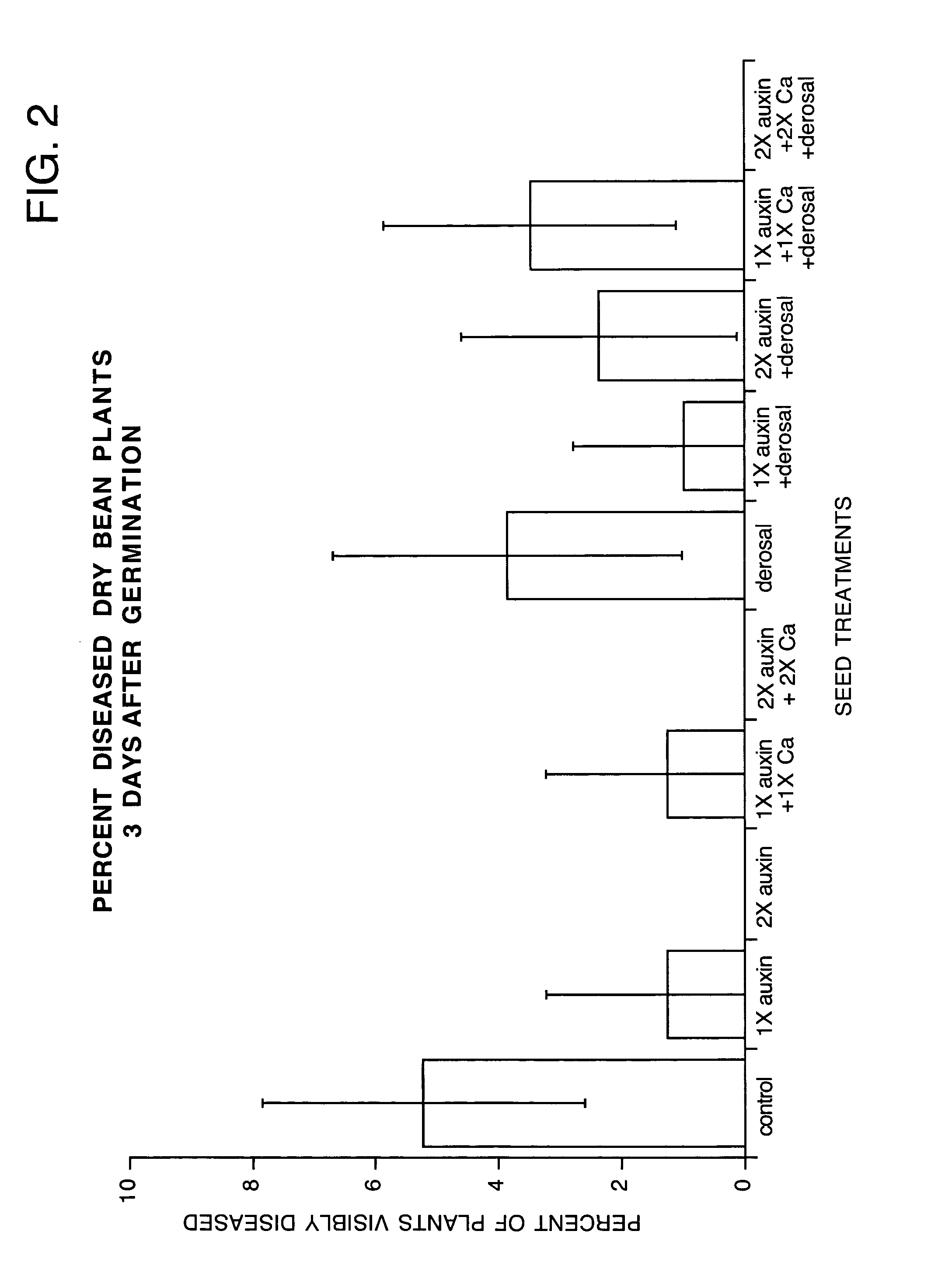Controlling plant pathogens and pests with applied or induced auxins
a technology of auxins and pests, applied in the field of control of plant pathogens and pests with applied or induced auxins, can solve the problem of insufficient application of auxins to negatively affect and achieve the effect of inhibiting the growth of harmful organisms and negatively affecting the growth of plant tissues
- Summary
- Abstract
- Description
- Claims
- Application Information
AI Technical Summary
Benefits of technology
Problems solved by technology
Method used
Image
Examples
example 1
[0044] In a field experiment, the effect of treatment of seeds with an aqueous solution containing plant growth regulators, including indole-3-acetic acid (IAA), was studied. In this experiment dry bean seeds were treated by application of an aqueous solution containing IAA, IBA, cytokinin, gibberellic acid and optionally calcium. Controls were merely treated with distilled water. Finally, other seeds were treated with an aqueous solution of Derosal, a commercially available fungicide containing carbendazim and thiram as the active ingredients. Finally, seeds were treated with a combination of the foregoing PGR, Derosal and calcium containing solutions. The various treatments are summarized in the left column of Tables I-V.
[0045] One hundred (100) kg of seeds were treated by spraying with 200, 400 or 600 ml of solutions containing PGR, calcium and / or Derosal in various combinations as listed. Each individual treatment was repeated with ten (10) replications. Nine (9) seeds were pla...
example 2
[0053] In this example, the effect of application of PGRs, principally indole-3-acetic acid (IAA), on the in vitro development of a soil fungus causing root rot in bean cultures, Rhizoctonia solani, was studied. Assessment of in vitro fungitoxic action of an auxin-containing solution on the Rhizoctonia solani fungus was undertaken for both single and sequential applications of PGR solutions.
[0054] A liquid culture medium (potato dextrose) was inoculated with 0.6 cm diameter discs of Rhizoctonia solani. Incubation conditions were maintained as 25° C with a photoperiod of 12 hours under constant agitation. Total incubation time was 60 hours. Growth of the inoculum was observed at 12 hour intervals. Each test was replicated in triplicate.
[0055] Single and sequential applications of an auxin-containing solution were studied. In the sequential tests, five (5) applications were made commencing with incubation and continuing at 12 hour intervals thereafter. In the single application, the...
example 3
[0058] In further experiments, the effect of PGRs, principally IAA, on thrips was examined. Whenever conditions are hot and dry, thrips, and more particularly their nymphs attack onions. It is the nymphs, rather than the thrips, that do most of the damage. There is no effective chemical control for the problem. In a controlled field experiment an aqueous solution containing PGRs, principally IAA, was applied to onions. Two different tests were conducted. In each test, growing onion plants were sprayed with an aqueous solution containing 0.015% IAA, 0.005% IBA, 0.009% cytokinin and 0.005% gibberellic acid at the rate of 12 oz per acre. The areas were enclosed with netting so that none of the thrips could move from one treatment zone to another. Untreated controls were sprayed with water. Seven days (test 1) and eight days (test 2) after application of the auxin-containing solution, the number of thrips (Thrips tabaci), both adult and larvae, were observed and counted. The results are...
PUM
 Login to View More
Login to View More Abstract
Description
Claims
Application Information
 Login to View More
Login to View More - R&D
- Intellectual Property
- Life Sciences
- Materials
- Tech Scout
- Unparalleled Data Quality
- Higher Quality Content
- 60% Fewer Hallucinations
Browse by: Latest US Patents, China's latest patents, Technical Efficacy Thesaurus, Application Domain, Technology Topic, Popular Technical Reports.
© 2025 PatSnap. All rights reserved.Legal|Privacy policy|Modern Slavery Act Transparency Statement|Sitemap|About US| Contact US: help@patsnap.com



